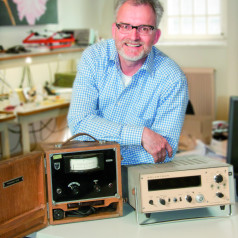Book review: Electronic Circuits for All
December 12, 2017
on
on

I met the authors of this book during the 2016 edition of Elektor’s Fast Forward Award event at the electronica trade show Munich. There, Michael Shustov and his son Andrey Shustov proudly presented a new composite-component called the baristor for barrier-resistor. And sure enough their contribution was awarded with a prize for taking home to their native country: Russia. Barring the odd opamp, Messrs Shustov’s designs invariably include 1970’s/80’s/90’s components of the dead common type besides some rarer ones, but always discrete parts of the kind you can still grab by two or three leads. Having heard the baristor discussed in Munich back in 2016 I was curious to see how these obvious fans of let’s say old school electronic parts fared in a book publication.
And indeed the "new" component is discussed at length in Electronic Circuits For All.
Some of the simpler circuits I saw in the book could have been redraws from Rudolf F. Graf’s Encyclopedia of Electronics or Elektor’s 30x Circuits books. It’s nice to think though that this is the “Russian” way of doing a compilation of 400+ simple electronic circuits when Graf admittedly is extremely American and Elektor, extremely European in his/their approach.
All circuits in the book look minimalist and seem to lack a certain refinement in terms of perfection tweaks like decoupling capacitors, tolerance indicators, grounded unused CMOS gates, and stopper resistors to mention a few of my personal favourites. Fortunately all circuits are printed large enough to be clearly legible.
So much for the first thing e-engineers do when they pick up a book: check out the circuits! The more the better! Are they any good?
And indeed the "new" component is discussed at length in Electronic Circuits For All.

400
Some of the simpler circuits I saw in the book could have been redraws from Rudolf F. Graf’s Encyclopedia of Electronics or Elektor’s 30x Circuits books. It’s nice to think though that this is the “Russian” way of doing a compilation of 400+ simple electronic circuits when Graf admittedly is extremely American and Elektor, extremely European in his/their approach.All circuits in the book look minimalist and seem to lack a certain refinement in terms of perfection tweaks like decoupling capacitors, tolerance indicators, grounded unused CMOS gates, and stopper resistors to mention a few of my personal favourites. Fortunately all circuits are printed large enough to be clearly legible.
So much for the first thing e-engineers do when they pick up a book: check out the circuits! The more the better! Are they any good?
Struggling with the words
The language used in the book to describe the operation of the circuits and components is odd in places, and reveals interference with German. Many sentences are comprehensible only if you have the ability to distil the correct English words and so get at what the authors want to get across. For example, the termRead full article
Hide full article

About Jan Buiting
Jan Buiting (1958) has been active in electronics and ways of expressing it since the age of 15. Attempts at educating Jan formally have so far yielded an F-class radio amateur license, an MA degree in English, a Tek Guru award, and various certificates in ele... >>



Discussion (1 comment)
Andrey Shustov 7 years ago
The reviewer had four main criticisms of the book:
- Using of old elements for the electronic devices.
- „Some of the simpler circuits could have been redraws from Rudolf F. Graf’s Encyclopedia of Electronics or Elektor’s 30x Circuits books” and therefore not really inventive.
- The translation of the technical text into English isn’t good enough.
- The authors apply the electronic devices in medicine as well as in some poorly studied areas of knowledge.
Before getting into the answering, we are going to list the main principles, that guided the authors in creating their devices.- Originality of design (device, circuit etc.) up to the invention level.
- Emphasized simplicity of devices and their multifunctionality.
- Availability, cheapness and interchangeability of the electronic parts and elements.
- Using of undocumented properties and operating modes of conventional electronic parts and elements for new purposes.
- A total effect is greater than expectations due to the synergies created by the new combinations of previously known element properties.
And now we answer to the above-mentioned criticisms of the reviewer.- Using of old elements for the electronic devices implies the possibility of a full replacement of the obsolete element by its more modern analog. It would not be good if the authors would use ultra-modern unique microchips for let’s say 100 euros.
- An assumption, that some of the simpler circuits could have been redraws from Rudolf F. Graf’s Encyclopedia of Electronics or Elektor’s 30x Circuits books, does not contain any argumentation or examples. Moreover, the authors claim that all the schemes given in the book are original, previously published in Russian-language magazines of the last 30 years. The level of originality can be estimated by reading at least the table of contents of the book. For many technical solutions, patents could be obtained by the authors, although they preferred to donate their many years of work to the public, calling it "Electronic circuits for all".
- The translation of the technical text into English isn’t perfect. Alas, this is so. Unfortunately, this is a common problem when translating a sophisticated technical text into foreign languages.
- This is no accident, that the authors apply the electronic devices in medicine as well as in some poorly studied areas of knowledge. What is better? To force the reader to "digest" all-known boring topics, which are described in detail in many books, or, to open the interested reader's eyes to the world of the unexplored, to help him to make new discoveries in the areas, in which a flight of fantasy would still be possible and where is a place for opportunities for self-improvement and development of the creative imagination.
We guess, the truth lies somewhere in the middle and we leave our book to the judgment of the demanding readers.Best regards
Michael Shustov and Andrey Shustov